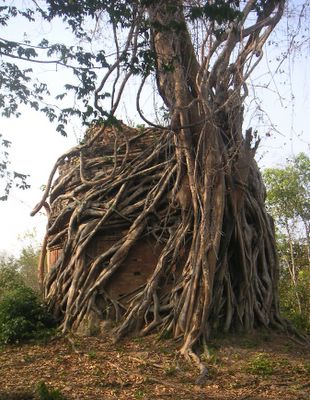Another Peek at Sambor Prei Kuk
Tan and Trev today continues its recollection of their trip to Sambor Prei Kuk [alternatively: Sambor Prey Kok] with this selection of images.

Copyright Tan and Trev 2005
Our guide told us these are some of the oldest structures in the Cambodia. Sambor Prei Kuk ('hillock in the forest of Sambor') was once the capital. The site was chosen by King Isanavarman I as the capital city of the Chenla Kingdom in the seventh century and was known as Isanapura.

Copyright Tan and Trev 2005
Our guide also told us that some of the oldest temples here are dedicated to Shiva. Many of these ancient buildings were surprisingly well preserved, while others were little more than tangled tree roots supporting slim brickwork.

Copyright Tan and Trev 2005

Copyright Tan and Trev 2005
We are told that there are more than 170 structures left spread across this site; some having fallen into ruin or suffered from vandalism, but a remarkable number given the the region's old and violent history.
The site, now a forest, was cleared and studied by the French experts in the 1960s. During that era, well-heeled tourists would visit en route to Angkor.
Later the site was virtually off limits due to civil war and the presence of the Khmer Rouge. So we consider ourselves fortunate to come at a time of improved security so that there is now again access to these rare ruins,

Copyright Tan and Trev 2005

Copyright Tan and Trev 2005

Copyright Tan and Trev 2005
Our guide told us these are some of the oldest structures in the Cambodia. Sambor Prei Kuk ('hillock in the forest of Sambor') was once the capital. The site was chosen by King Isanavarman I as the capital city of the Chenla Kingdom in the seventh century and was known as Isanapura.

Copyright Tan and Trev 2005
Our guide also told us that some of the oldest temples here are dedicated to Shiva. Many of these ancient buildings were surprisingly well preserved, while others were little more than tangled tree roots supporting slim brickwork.

Copyright Tan and Trev 2005

Copyright Tan and Trev 2005
We are told that there are more than 170 structures left spread across this site; some having fallen into ruin or suffered from vandalism, but a remarkable number given the the region's old and violent history.
The site, now a forest, was cleared and studied by the French experts in the 1960s. During that era, well-heeled tourists would visit en route to Angkor.
Later the site was virtually off limits due to civil war and the presence of the Khmer Rouge. So we consider ourselves fortunate to come at a time of improved security so that there is now again access to these rare ruins,

Copyright Tan and Trev 2005

Copyright Tan and Trev 2005



0 Comments:
Post a Comment
<< Home